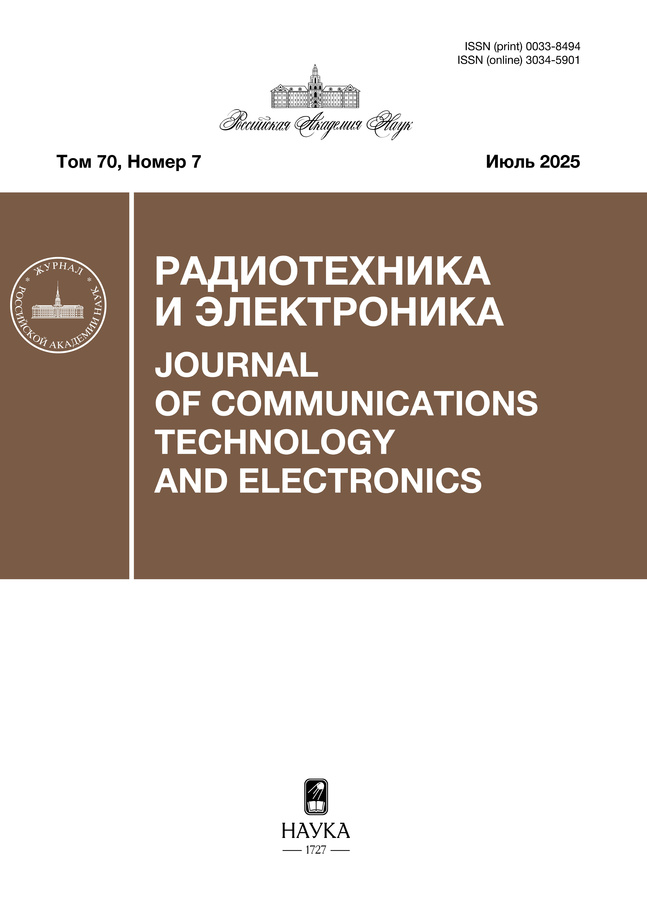Statistical model of directional fading for land-mobile satellite communication systems. Part 2
- 作者: Karavaev D.A.1, Glushankov E.I.1
-
隶属关系:
- The Bonch-Bruevich Saint Petersburg State University of Telecommunications
- 期: 卷 70, 编号 7 (2025)
- 页面: 644-650
- 栏目: THEORY AND METHODS OF SIGNAL PROCESSING
- URL: https://cardiosomatics.ru/0033-8494/article/view/692008
- DOI: https://doi.org/10.7868/S3034590125070039
- ID: 692008
如何引用文章
详细
This paper presents a refined model of the flat fading stochastic process in satellite communication channels caused by multipath propagation when using narrowbeam receiving antennas. The key improvement over prior model lies in a reparameterization that explicitly accounts for the main lobe of a typical antenna radiation pattern, following ITU-R recommendations. For the proposed model, we derive expressions for level-crossing rate and average fade duration. The simulation of DVB-S2X VL-SNR signal propagation over fading channel based on derived model was performed, which demonstrates negligible loss in error resilience under fading depths most frequently observed in practice.
作者简介
D. Karavaev
The Bonch-Bruevich Saint Petersburg State University of Telecommunications
Email: d-a-karavaev@yandex.ru
Bolshevikov prosp., 22, build. 1, St. Petersburg, 193232 Russian Federation
E. Glushankov
The Bonch-Bruevich Saint Petersburg State University of TelecommunicationsBolshevikov prosp., 22, build. 1, St. Petersburg, 193232 Russian Federation
参考
- Караваев Д.А., Глушанков Е.И. // РЭ. 2025. Т. 70. № 7. С.
- Stüber G.L. Principles of Mobile Communication. Сham: Springer, 2017.
- Recommendation ITU-R F.1245–3. Mathematical Model of Average and Related Radiation Patterns for Point-to-Point Fixed Wireless System Antennas for Use in Interference Assessment in the Frequency Range from 1 GHz to 86 GHz. Geneva: Int. Commun. Union, 2019. 12 p.
- Recommendation ITU-R BO.1213. Reference Receiving Earth Station Antenna Pattern for the Broadcasting-Satellite Service in the 11.7–12.75 GHz Band. Geneva: Int. Commun. Union, 2005. 5 p.
- Mardia K.V., Jupp P.E. Directional Statistics. Chichestar: John Wiley & Sons, 2000.
- Net M.S. Analysis of the Fading Channel in Downlinks from the Lunar South Pole to the Deep Space Network. IPN Progress Report 42–216. Washington: NASA, 2019. 30 p.
- Hoeher P., Haas. E. // IEEE VTS50th Vehicular Technology Conf. Amsterdam. 19–22 Sept. N. Y.: IEEE, 1999. V. 4. P. 1961.
- Wee Teck Ng., Dubey V.K. // IEEE Commun. Lett. 2002. V. 6. № 11. P. 472.
- European Standard ETSI EN302 307–2 V1.4.1. Digital Video Broadcasting (DVB); Second generation framing structure, channel coding and modulation systems for Broadcasting, Interactive Services, News Gathering and other broadband satellite applications; Part 2: DVB-S2 Extensions (DVB-S2X). Sophia Antipolis: Europ. Standards Telecommun. Inst., 2024. 166 p.
- Technical Report ETSI TR102 376–2 V1.2.1. Digital Video Broadcasting (DVB); Implementation guidelines for the second-generation system for Broadcasting, Interactive Services, News Gathering and other broadband satellite applications; Part 2: S2 Extensions (DVB-S2X). Sophia Antipolis: Europ. Standards Telecommun. Inst., 2021. 212 p.
- Casini E., De Gaudenzi R., Ginesi A. // Int. J. Satellite Commun. and Networking. 2004. V. 22. P. 281. https://doi.org/10.1002/sat.791
- Technical Report ETSI TR102 768 V1.1.1. Digital Video Broadcasting (DVB); Interaction channel for Satellite Distribution Systems; Guidelines for the use of EN301 790 in mobile scenarios. Sophia Antipolis: Europ. Standards Telecommun. Inst., 2009. 111 p.
补充文件









